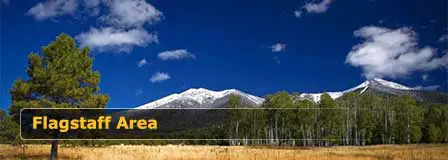Lowell Observatory
Travel back in time to the year 1930, when the Universe consisted of just eight planets and the astronomical community was working feverishly to map and measure the extent of the galaxy. Imagine the excitement when, on a clear February night high upon a hill just outside of downtown Flagstaff, a young astronomer by the name of Clyde Tombaugh discovered what has since become known as the dwarf planet Pluto. Just twenty-four years old at the time, Tombaugh's discovery quickly pushed the then forty year old Lowell Observatory to the forefront of astronomical research, where Flagstaff's scientific gem remains today.

Lowell Observatory Today
Lowell Observatory is an astronomical research observatory with multiple campuses throughout the Flagstaff area. Founded in 1894 by Percival Lowell, the Observatory's main public education facility is found at Mars Hill, about a mile from downtown Flagstaff. Lowell believed Mars had the capability of supporting intelligent life and his astronomy interests focused on researching that possibility. Over the years the Lowell Observatory has been responsible for or contributed to the discovery of such galactic wonders as the rings of Uranus, the three largest known stars, the speed of galaxies moving away from the earth which led Edwin Hubble to determine the universe is expanding and of course, Tombaugh's discovery of Pluto. Today the Mars Hill campus entertains 70,000 visitors annually, drawn to the facility by its outstanding scientific research, educational programs and scenic beauty.
Things to See
The heart of the Mars Hill site is the Clark Telescope, the Observatory's original 24-inch refracting telescope. Visitors flock to the Observatory both day and night to view the wonders of the sky through this classic piece of scientific history. Also on the Mars Hill campus is the Pluto Discovery Telescope, used by Tombaugh to identify the dwarf planet Pluto, and the Slipher Building Rotunda. A special solar telescope is also set up during the day to view sunspots and sun flares, providing visitors with both a safe and exciting way to view the earth's closest star, the Sun.
One of the more stimulating exhibits at the Lowell Observatory is the Pluto Walk, a 350 foot model of the solar system. This guided tour leads visitors through the expanse of our solar system as they wind their way up the spiral climb to the Pluto Discovery Telescope. The forty-five minute tours leave every hour on the hour between 10 AM and 4 PM and include stops at the Clark telescope, the Slipher Rotunda and the Pluto telescope. Of special note, while the Clark telescope and Slipher Rotunda are fully accessible, the Pluto telescope is not because of steep, spiral stairs leading up to the Pluto dome.
After your tour stop by the Steele Visitor Center. The Discover the Universe exhibit hall takes visitors on an interactive walk through the Milky Way and surrounding universe, while the multimedia auditorium shows true "star-studded" programming continually throughout the day. The John Vickers Space Theatre shows exciting films every hour and at night observatory staff headline "Sky Tonight", a multimedia presentation that introduces visitors to the wonders of the nighttime sky.
Looking for a unique astronomical experience? The Lowell Observatory offers individual programs including theatre presentations and private access to the many telescopes for that truly personal galactic experience. One-hour daytime programs are available for $70 and ninety minute evening programs cost $150. (Fees subject to change)
While the Mars Hill site is Flagstaff's one-stop shop for star gazing and public education, Lowell Observatory continues its historic research mission at its Anderson Mesa site approximately 12 miles southeast of Flagstaff. Here scientists from around the country partner with the Observatory to study asteroids and other objects traveling near the earth. Anderson Mesa is also home to several joint research projects with such distinguished affiliations as the Naval Research Laboratory and Boston University, continuing Percival Lowell's dream of ongoing astronomical study.
On the Horizon
Visitors to the Lowell Observatory can learn about the Discovery Channel Telescope, an historic endeavor partnered with Discovery Channel Communications. Currently under construction forty miles southeast of Flagstaff in the Coconino National Forest, the Discovery Channel Telescope will enable Lowell Observatory astronomers to reach farther and deeper into the universe and once completed in 2010 will be the fifth largest telescope in the United States. Check out the progress on the new telescope at the Steele Visitor Center at the Mars Hill site.
Getting to Lowell Observatory
Conveniently located near downtown Flagstaff, Lowell Observatory is a short drive from the historic sites of the Riordan Mansion State Historic Park and the Arboretum at Flagstaff. Bordering Thorpe Park, Lowell Observatory is located at 1400 W. Mars Hill Road. From Interstate 40 take exit 195 toward AZ-89A/Flagstaff. Merge onto I-17 North which turns into South Milton Road. Turn left on Santa Fe Avenue before making a slight right onto West Mars Hill Road. The Observatory is open daily between 9 AM and 5 PM, before opening again in the evening between 5:30 and 10 PM for star gazing and nighttime viewing, weather permitting.
More Information
Flagstaff High Country
Enjoy Cool Flagstaff
Flagstaff Arizona
Map & Directions
Weather & Climate
Miles to Arizona Cities
Picture Gallery
Distance To Attractions
About Flagstaff AZ
Lakes Near Flagstaff
Blue Ridge Reservoir
Upper Lake Mary
Mormon Lake
Kinnikinick Lake
Ashurst Lake
Flagstaff Fishing
Scenic Drives
Oak Creek Canyon
Arizona Route 66
Peaks Loop Drive
Schultz Pass Road
Snowbowl Scenic Drive
Things To Do
Scenic Railways
Cliff Castle Casino
Snow Skiing
Flagstaff Camping
Flagstaff Golfing
Flagstaff Museums
Area Attractions
Lake Powell
Wupatki Ruins
San Francisco Peaks
Grand Canyon
Walnut Canyon
Humphreys Peak
Meteor Crater
Sunset Crater
Historic Downtown
Arizona Snowbowl
Lowell Observatory
Arboretum of Flagstaff
Where To Stay
Cabin Rentals
RV Parks & Campgrounds
Bed and Breakfast
Conifer House
Aspen Inn
England House
Flagstaff Articles
Kids Snow Play
Dress For Flagstaff
Nearby Cities
Williams Arizona















